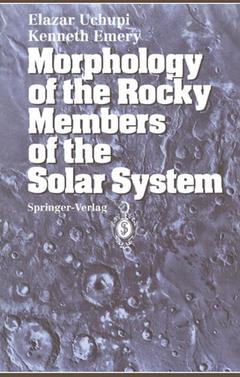Morphology of the Rocky Members of the Solar System, Softcover reprint of the original 1st ed. 1993
Langue : Anglais
Auteurs : Uchupi Elazar, Emery Kenneth O.
Préfacier : Dietz R.S.

These words are written on the SOOth anniversary of Columbus' discovery of the New World. Surely the deep-space exploration of other worlds in our Solar System over the past few decades is an event of similar magnitude. Man has traveled far enough to see Spaceship Earth suspended alone in black space. And he has voyaged even farther to marvel at the crescent Earth rising over the Moon's cratered terrain. Instrumented spacecraft have toured the entire Solar System even beyond the ninth planet Pluto. This work of science Morphology of the Rocky Members of the Solar System is an inquiry about our extended home. As with the Darwinian and Copernican paradigms, the nature of our planetary system, as the extended world around us, has great significance for those who ponder the human condition. The deep-space views of our Planet Ocean with its sweeping clouds, and moving oceans and creeping continents must rank as the greatest photograph ever taken. Viewing Spaceship Earth hanging in the vast void is an almost frightening experience. We are so alone! It is easy to understand why so many are attracted to a simpler account of origins, like the allegorical tale of creation written in heroic style (but eschewing math, maps, figures, tables, references, and evidence) in the first eleven chapters of Genesis. This treatise examines the morphology of the six rocky planets and their 27 satellites from a broad perspective.
1 Introduction.- 2 Origin of the Solar System.- 2.1 General Properties of Galaxies, Stars, and Sun.- 2.2 The Solar System.- 2.3 Development of Thought About the Origin.- 2.4 Modern Concepts About the Origin.- 2.4.1 Sun, Planets, and Moons.- 2.4.2 The Meteoritic Complex.- 2.4.2.1 Meteorites.- 2.4.2.2 Asteroids.- 2.4.2.3 Comets.- 2.4.3 Companion Star and the Tenth Planet.- 3 Morphology of Planets and Satellites.- 4 Earth.- 4.1 Early History, Structure, and Hydrosphere.- 4.2 Atmosphere and Biosphere.- 4.3 Hypsometry.- 4.4 Morphology.- 4.4.1 Endogenic.- 4.4.2 Exogenic.- 4.4.3 Exotic.- 5 Moon.- 5.1 Origin.- 5.2 Composition.- 5.3 Hypsometry.- 5.4 Morphology.- 5.4.1 Exotic.- 5.4.2 Endogenic and Exogenic.- 5.5 Chronology.- 6 Mercury.- 6.1 Observations.- 6.2 Hypsometry.- 6.3 Morphology.- 6.3.1 Exotic.- 6.3.2 Endogenic.- 6.4 Chronology.- 7 Venus.- 7.1 Early History and Structure.- 7.1.1 Planetary Setting.- 7.1.2 Hydrosphere.- 7.1.3 Core, Mantle, and Lithosphere.- 7.1.4 Tectonic Models.- 7.2 Hypsometry.- 7.3 Morphology.- 7.3.1 Exotic.- 7.3.1.1 Impact Craters.- 7.3.2 Endogenic.- 7.3.2.1 Plains.- 7.3.2.2 Tesserae.- 7.3.2.3 Highlands.- 7.3.2.4 Volcanoes and Intrusives.- 7.3.3 Exogenic.- 7.3.4 Summary.- 8 Mars.- 8.1 Planetary Setting.- 8.2 Satellites.- 8.3 Hypsometry.- 8.4 Morphology.- 8.4.1 General.- 8.4.2 Chronology.- 8.4.3 Exotic.- 8.4.4 Endogenic.- 8.4.4.1 Densely Cratered Terrains.- 8.4.4.2 Sparsely Cratered Plains.- 8.4.4.3 Flow and Ridged Plains.- 8.4.4.4 High-Latitude Plains.- 8.4.4.5 Volcanoes.- 8.4.4.6 Tectonism.- 8.4.5 Exogenic.- 8.4.5.1 Erosional Features.- 8.4.5.2 Chaotic, Fretted, Grooved, and Knobby Terrains.- 8.4.5.3 Depositional Features.- 8.4.6 Summary.- 9 Outer Planets and Satellites.- 9.1 Exploration.- 9.2 Jupiter and Satellites.- 9.2.1 Planetary Setting.- 9.2.2 Inner Satellites.- 9.2.2.1 General.- 9.2.2.2 Amalthea.- 9.2.3 Galilean Satellites.- 9.2.3.1 General.- 9.2.3.2 Io.- 9.2.3.3 Europa.- 9.2.3.4 Ganymede.- 9.2.3.5 Callisto.- 9.2.4 Outer Satellites.- 9.2.5 Summary.- 9.3 Saturn and Satellites.- 9.3.1 Planetary Setting.- 9.3.2 Satellites.- 9.3.3. Summary.- 9.4 Uranus and Satellites.- 9.4.1 Planetary Setting.- 9.4.2 Satellites.- 9.4.2.1 General.- 9.4.2.2 Puck.- 9.4.2.3 Miranda.- 9.4.2.4 Ariel.- 9.4.2.5 Umbriel.- 9.4.2.6 Titania.- 9.4.2.7 Oberon.- 9.4.3 Summary.- 9.5 Neptune and Satellites.- 9.5.1 Planetary Setting.- 9.5.2 Satellites.- 9.5.2.1 General.- 9.5.2.2 Triton.- 9.6 Pluto and Charon.- 10 Summary and Conclusions.- 10.1 Introductory Statement.- 10.2 Properties Inherited From the Origin of the Solar System.- 10.3 Morphologies Developed After Separation of the Planets.- 10.3.1 Exotic.- 10.3.2 Endogenic.- 10.3.3 Exogenic.- 10.3.4 Summary.- 10.4 Oceans of Magma and Other Non-Water Liquids.- 10.5 Ocean Basins and Water Oceans.- 10.6 Atmospheres.- 10.7 Life and Its Role in Structure and Morphology.- 10.8 The Improbability of an Earth.- References.
Date de parution : 05-2012
Ouvrage de 394 p.
15.5x23.5 cm
Disponible chez l'éditeur (délai d'approvisionnement : 15 jours).
Prix indicatif 52,74 €
Ajouter au panierThèmes de Morphology of the Rocky Members of the Solar System :
© 2024 LAVOISIER S.A.S.



